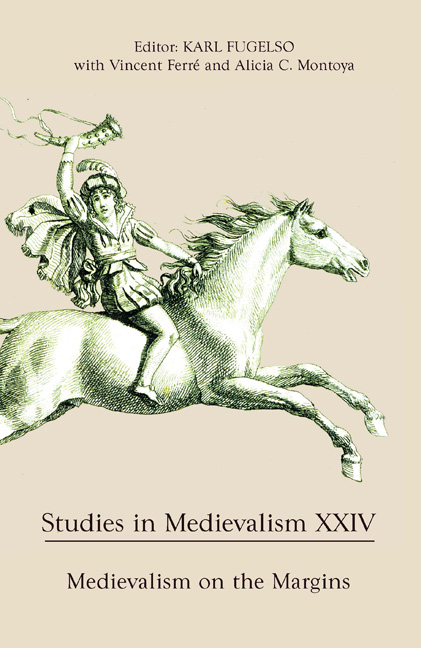Book contents
- Frontmatter
- Acknowledgments
- Contents
- List of Illustrations
- Volume XXIV 2015
- Editorial Note
- I Medievalism on the Margins: Some Perspective(s)
- 1 Medievalism in the Margins: Paratexts and the Packaging of Medieval French Literature
- 2 Medievalism Studies and the Subject of Religion
- 3 Pop Medievalism
- 4 Ecomedievalism: Applying Ecotheory to Medievalism and Neomedievalism
- 5 Whiteness and Time: The Once, Present, and Future Race
- 6 A Desire for Origins: The Marginal Robin Hood of the Later Ballads
- 7 Women, Queerness, and Massive Chalice: Medievalism in Participatory Culture
- 8 “Constant inward looking,” Medieval Devotional Literature, and the Concordium-Fruitlands Library
- II Trans-Atlantic Medievalism(s)
- III Other Interpretations
- Contributors
7 - Women, Queerness, and Massive Chalice: Medievalism in Participatory Culture
from I - Medievalism on the Margins: Some Perspective(s)
Published online by Cambridge University Press: 05 December 2015
- Frontmatter
- Acknowledgments
- Contents
- List of Illustrations
- Volume XXIV 2015
- Editorial Note
- I Medievalism on the Margins: Some Perspective(s)
- 1 Medievalism in the Margins: Paratexts and the Packaging of Medieval French Literature
- 2 Medievalism Studies and the Subject of Religion
- 3 Pop Medievalism
- 4 Ecomedievalism: Applying Ecotheory to Medievalism and Neomedievalism
- 5 Whiteness and Time: The Once, Present, and Future Race
- 6 A Desire for Origins: The Marginal Robin Hood of the Later Ballads
- 7 Women, Queerness, and Massive Chalice: Medievalism in Participatory Culture
- 8 “Constant inward looking,” Medieval Devotional Literature, and the Concordium-Fruitlands Library
- II Trans-Atlantic Medievalism(s)
- III Other Interpretations
- Contributors
Summary
On 30 May 2013, the game studio Double Fine launched a campaign on the crowdsourcing website Kickstarter in order to raise funds for their next project: Massive Chalice, a neomedieval turn-based tactical strategy video game. Unlike a number of other game campaigns on Kickstarter, which often call for pledges close to a project's release date, Double Fine decided to launch its campaign for Massive Chalice in the pre-production phase of the game's development, and thereby encourage feedback on the game's design from the website's community at large. Double Fine's invitation to involve backers in shaping the game's development not only spurred overwhelming financial support (and a successful campaign), but also elicited discussions among gamers and critics concerning the game's design philosophies, especially in regard to gender equality and same-sex representation in the game's organization of generational bloodlines. This essay examines what can happen to the depiction of women and queer individuals in neomedieval games – characters who are typically underrepresented – when these games are thrust into a newly participative process of production and game development.
Massive Chalice reflects a growing cultural shift in the production of video games. While neomedieval video games have existed for over thirty years, beginning with text-based games such as Colossal Cave Adventure (1976), primitive development tools and high production costs formed a rigid development process, making it difficult for developers (often large game studios) to alter a game's design. Limited mass-communication technology also impeded any incorporation of player feedback. In the 1970s and 1980s, for instance, game companies adopted test-group models for determining player interest. As game historian Steven Kent explains: “[b]efore manufacturing games, Atari tested prototype games in selected arcades to gauge player response. If a game had strong earnings, the company sent it to manufacturing. If a game did poorly, its design team could either find ways to improve it or abandon it altogether.”
- Type
- Chapter
- Information
- Studies in Medievalism XXIVMedievalism on the Margins, pp. 63 - 74Publisher: Boydell & BrewerPrint publication year: 2015



